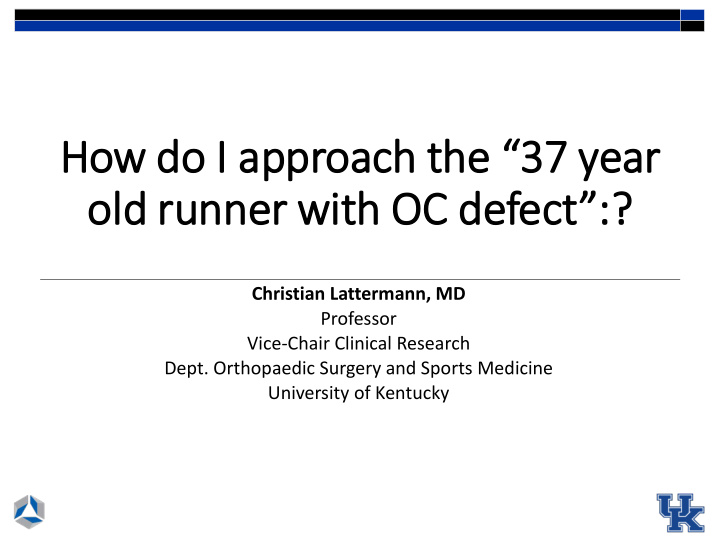



How do I approach t the “ e “37 37 y yea ear old r runner er wi with OC OC defec ect”: ”:? Christian Lattermann, MD Professor Vice-Chair Clinical Research Dept. Orthopaedic Surgery and Sports Medicine University of Kentucky
I do have financial disclosures to make • Industry: • Vericel: Consultant • Cartiheal: Consultant • Samumed: Consultant • Novartis: Consultant • Smith&Nephew : Institutional Support • Current Grant Support: • NIH-NIAMS: 1K23AR060275-01A1 (2012-2017) • Editorial Board Memberships: • Cartilage • Journal of Sports Rehabilitation • The Knee • Orthopaedic Journal of Sports Medicine • Reviewer for Journals: • AJSM, CORR, JKS, O&C, Orthopaedics, • Patents: • 09/561,524 ;PCT/EP98/06849
Activity level: Long distance runner Recreational runner Gait / form Recent changes to his technique Pain characteristics: Only with running activity or with any activity Sharp and specific or dull and achy Accompanied with effusion or not Mechanical Location
• Long leg alignment films are mandatory if you evaluate for chondral defects • Correct if more than 3-5 degrees varus or valgus • Does location of lesion correspond with malalignment? • What effect does unloading have? • If PF joint: assess instability/ PF overload
Location: • Condyle: • midcenter MFC or LFC, small lesion (2cm 2 ): autologous cell therapy or OCA • periphery, uncontained lesion: autologous cell therapy • PF joint: • first line autologous cell therapy or allogeneic cell therapy • OCA and autograft plugs only in revision situations Size: • Fixable: repair • salvage (larger than 6cm 2 ): salvage Depth: • chondral: autologous cell based > OCA • Subchondral: OCA > cell based OA: • Scope appearance • Synovitis • Other compartments? • => any cell or chondral plug technique will have reduced outcomes expectations and an increase in failure rate
• Patient expectations: • Return to previous level or not? • A conditioned runner who developed the lesion during his normal routine • Return to higher level? • The 39 year old weekend warrior who decided that a marathon or 10 have to be completed before the end of year (the cross-fit phenomenon) • Timelines for recovery: • Realistic time frame for cartilage surgery recovery: • i.e. crutches, PT, car driving • Realistic time frame for return to running: • i.e. 6-9 months or more, reduction in frequency and intensity likely • Endgame: • Be physically active • Run that “one marathon” • Have a pain free knee for many years
• Cell based: • first choice for longevity and preservation • Preserve potential biological bail out (OCA) • Allograft: • Second choice, possible bail out • subchondral bone edematous or injured • If quicker recovery to performance is necessary => trading safety and options for performance • Autograft: • Only if small (1cm 2 ) lesion • Beware of PF joint in a runner • Marrow stimulation: • In that age group will likely fail • Can be considered for very short term gain • “Cartilage Voodoo and pixie dust”: • No indication in my practice due to complete lack of data
• Manage Expectations • Be honest with your patient, particularly runners tend to tolerate limitations • Always think alignment • No heroism, it will not be rewarded • deal with disappointment before surgery rather than after surgery • Go for established over novel
Tha hank y you! u!
Recommend
More recommend